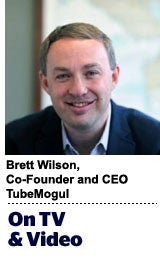 “On TV And Video” is a column exploring opportunities and challenges in programmatic TV and video.
“On TV And Video” is a column exploring opportunities and challenges in programmatic TV and video.
Today’s column is written by Brett Wilson, co-founder and CEO at TubeMogul.
In headline after headline, the word “programmatic” is often followed by the words “fraud,” “viewability” or “transparency concerns.” An outsider to the ad industry could be forgiven for thinking that “programmatic buying” is the Madison Avenue equivalent of using electronic trading to trade subprime mortgage securities.
While these concerns are valid and worth answering, we need to consider how we got here. “Programmatic” is widely defined simply as using software to automate ad buying, a process that was previously manual. In that sense, blaming programmatic for something like bad viewability rates is akin to blaming an online brokerage for a bad trade.
The difference is history. In years past, programmatic buying was limited to real-time bidding (RTB) and ad exchanges – perilous waters for brand marketers without the right tools. But the tide is turning. More than half of display ads bought programmatically are direct buys, meaning software simply automates a private deal.
The trend in video will likely be more pronounced given its relative scarcity. There are some brands that do not buy RTB inventory at all but are still consolidating video budgets through automated software.
So why are we still associating software with quality of media?
The idea is often propagated for reasons that have nothing to do with automated buying. In some cases, agencies are protecting legacy business models by spreading the idea that programmatic is just a tactic to be used to scale audience buys or achieve performance objectives, while premium inventory should be bought and negotiated through media buyers and the tired I/O process.
In other cases, programmatic is leveraged as a tactic to create new revenue streams by steering spending toward preferred – though not necessarily the most premium – publishers via private marketplaces.
Either way, the thinking is often short-term when we should be rebuilding legacy models and retraining talent for the long-term.
As a result, brands are discouraged from fully leveraging technology across the largest component of their ad buys, their private deals with premium publishers. That is unfortunate, because the infrastructure is in place to make all ad buys more effective – not just RTB or preferred private marketplaces.
The benefits of consolidating all ad budgets through software are clear: streamlined planning and execution, the ability to control reach and frequency across publishers and improved campaign performance from automated optimization and unified reporting.
These benefits do not need to end with digital advertising – eventually, software may even be used for upfront TV buys. Breakthroughs in the past year in extending automated buying to traditional formats – out-of-home, print and TV – point to a future where any media channel can be bought through software.
But we won’t get there until we can all agree that programmatic is more than a reach play. So let’s make our world a little less complex today by agreeing on this: Programmatic is just software used to automate ad buys, of both open and private inventory.
Follow Brett Wilson (@bjwilson34), TubeMogul (@TubeMogul) and AdExchanger (@adexchanger) on Twitter.












